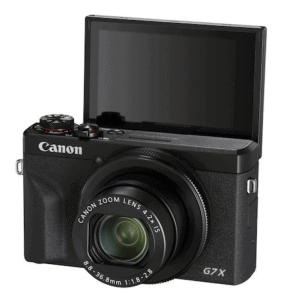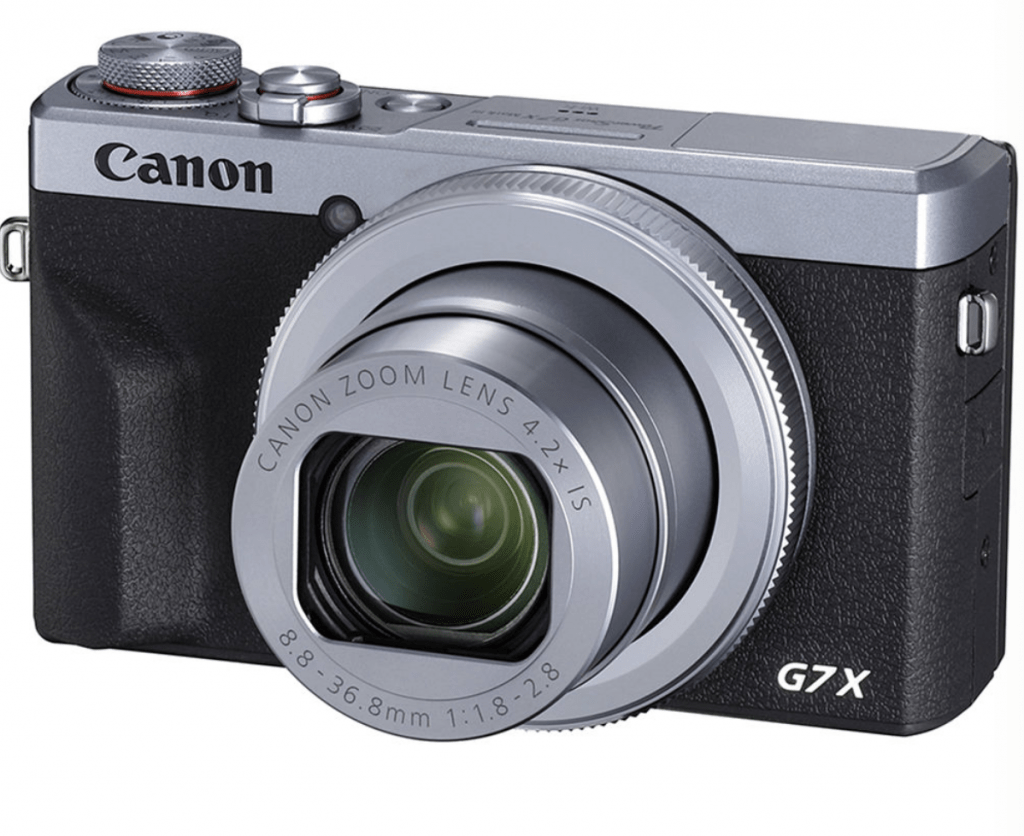Powerful and Compact Flip Screen Vlogging Camera
Why is the Canon G7X Mark III good for vlogging? When I read “ideal for vloggers” on the official website of Canon, I made up my mind to buy it. After using the G7X Mark III for some time now, I’ve grown to love it.
When Canon introduced it’s G7X Mark II, it wasn’t initially marketed as a camera for vloggers. But after video content creators began to use it, it instantly became a success and became popular choice. So, Canon came up with some improvements while entirely focusing on making it “the camera for vloggers.“
Here’s what I like about the Canon G7X Mark III:
Design
- Premium Build with a firm grip
- Responsive LCD
- 3.5mm mic input
- Small enough to carry it around
Compact cameras are usually hard to handle due to their size, but with this Canon camera, you won’t feel any such problem.
It is a reliable premium camera, which has a firm grip and a thumb rest. The dials on its top have red accents around them and have enough resistance so that you don’t rotate them accidentally.
Canon has made intelligent use of the space across the camera. On it’s top surface, the exposure compensation dial sits below the mode dial, while on the lens, there is a control ring that lets it’s key settings adjust quickly. There is also a little change from its previous editions where a Ring function is now AE/AF lock.

The LCD is very responsive to touch, and it’s 3 inches in size. For vlogging , it can be flipped upward by 180° or down by 45° for overhead shooting. There are three ports on the camera: a mic input on the left, and USB and HDMI on the right. The USB transfer speed is 2.0 and it uses a Type-C socket.
It comes with a dedicated audio-in port so that you can use any third-party microphones with it. The body is a mix of metal and plastic. The weight is 10 ounces, and at 2.4 by 4.1 by 1.6 inches, it’s small enough to slide into your pocket comfortably.
Specs
- 4K UHD recording
- 120fps FHD recording
- 30fps RAW shooting
- Live streaming to YouTube
- EOS style interface
The Canon G7X Mark III comes packed with a newly designed 20.1 MP 1 inch CMOS sensor combined with the Canon Digic 8 processing for high-speed continuous shooting rates. It uses a larger sensor coupled with a bright lens so that you can shoot at up to 30fps (frames per second) in RAW Burst Mode for up to 70 images.
Keeping in view of the fact that the previous G7X models were popular among vloggers, it’s no surprise that Canon has come up with significant changes. It has embedded 4K UHD recording, while being able to live stream to YouTube. The features also include Bluetooth and WiFi.
Overall, the specs of the camera are promising with excellent video and image quality.
***Canon has released a firmware update on October 24, 2019 (1.1.0). Make sure you install this if you have had the camera prior to the update!
Why the G7x Mark III is better than the G7X Mark II
After using the G7X Mark III, I can surely say that the video and audio quality is better – 4K makes a world of difference and 120fps FHD is awesome for shooting cinematic B-Roll.
For the avid videographer, the video features are excellent as you have many new modes. Though, for casual vloggers and creators, the autofocus system might not keep up with your on-the-go video demands.
In this video by Think Media, Sean explains a little bit more about the differences of the two cameras, and tests them for you to compare.
PROS
- Compact, pocket-friendly design
- Tilt friendly touch LCD monitor
- 4K Video + 120fps Video
- Live YouTube video streaming
- Great autofocus speed
- Wide-angle 4.2x zoom
- Wireless WIFI networking, NFC and Bluetooth
- High performance, even in low light
- Fast maximum aperture
- 1-inch sensor
- Excellent image quality, mainly when shooting RAW
CONS
- Not the best battery life
- No EVF (electronic viewfinder)
- Weak Built-in flash
- Soft corners at wide-angle
Cheaper Alternatives to the Canon G7X Mark III:
Sony Cyber-shot RX100 V

Sony Cyber-shot RX100 V can be a great alternative to G7X Mark III. It is the 5th version of the Sony Cyber-shot RX100.
Some of the key specs of this camera are:
- 20MP 1″-type stacked BSI-CMOS sensor
- 24-70mm Equiv. F1.8-2.8 zoom lens
- 24fps burst shooting in JPEG + Raw, with full AF and AE
- 315-point phase-detection autofocus system
- Detailed 4K video capture with well-controlled rolling shutter
Canon Powershot G5 X Mark II
Canon Powershot G5 X Mark II is another excellent alternative to the camera in the discussion.
Some key specs of this camera are:
- 20MP 1″-type stacked CMOS sensor
- 24-120mm Equiv. F1.8-2.8 lens
- Pop-up electronic viewfinder and flash
- Touchscreen tilts up 180° and down 90°
- 8fps burst shooting with autofocus, 30fps Raw burst mode
- 4K/30p, 1080/60p video recording with IS (no 24p options)
- 1080/120p slow-motion video with no audio or autofocus
- Wi-Fi + Bluetooth wireless connectivity
- USB 3.1 (with USB-C connector) for data transfer and charging
- 230-shot battery life (180 using the EVF) per CIPA standard
Panasonic Lumix LX10
If you are a Panasonic fan and looking for an alternate for Canon G7X Mark III then this Panasonic camera is for you.
Some key specs of this camera are:
- 20MP 1″-type CMOS sensor
- 24-72mm equivalent F1.4-2.8 zoom
- Seven fps continuous shooting with autofocus
- 4K video at up to 30p
- 5-axis, digital and optical stabilization in 1080 video
- 4K Photo mode
- Post Focus and Focus Stacking modes
Conclusion
Canon G7X Mark III might seem like a small upgrade from its predecessor but rest assured it comes with loads of internal improvements, with features such as powerful videography even in lowlight, live YouTube streaming, 4K Video and an external mic input. All of this packed into a small pocket-friendly body makes it, Canon’s best shot yet at “the camera for vloggers”.
Hopefully this articled has gave you some valuable information on the Canon G7X Mark III. You can view our review of the Canon G7X Mark II here!
Check out some of our other posts!




Leave a Reply